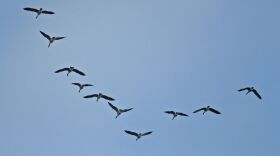While we are accustomed to birds nesting in spring, we have one bird species here that is just finishing their nesting season.
The American Goldfinch is the subject of this week’s Wildlife Matters.
Recently my wife and I were driving one of the beat-up roads out by the Rhinelander airport, and a brief golden flash caught my eye. “Look! My first goldfinch sighting of the year” I exclaimed. It was a brilliantly colored male, but he disappeared in an instant amongst the young aspen trees outside the fence. My wife didn’t see him; I started telling her a little bit about these birds, to which she replied it might make a good topic for Wildlife Matters.
Now I tend to write about birds a lot, and I don’t want to get tangled up with any other feature contributors whose sole focus is birds and stuff related to birds. At the same time, there is so much about birds and our relationships to them, it is to me as endless a conversation topic as the weather or cooking might be to others.
When I write about birds, I really like to focus on what makes them different. Goldfinches are truly finches, but as I was growing up, my dad would always refer to them as wild canaries. Those of you familiar with these birds might understand the confusion—they are as bright a yellow as any canary you might see in a cage. In fact, goldfinches molt twice a year, the only member of the finch family to do so. They change feathers in late winter, so they are fresh and bright for the breeding season, and they change again in late summer.
As with all finches, these birds are seed eaters, but they are probably the most fastidious seed eaters among all birds. Some other finches will eat insects when it is a good hatch, or when feeding young, or they just need some protein. Not goldfinches; it almost seems the only time they might consider eating a bug is if they accidentally flew through a swarm of bugs with their mouth open.
Of all the seeds that goldfinches eat, thistle seeds are by far their favorite. Even if you are not a biologist, if you feed birds you probably know your best chance of seeing goldfinches is if you put out a thistle sock or thistle tube. Their relationship with thistles extends even further; they use copious amounts of thistle-down in their nests. These birds rely so heavily on thistles, it is thought, that they time their nesting when the thistles produce their downy seed to provide nesting material and food for themselves and their young. This means the bird I saw in July could well have been nesting or possibly feeding young, at a time when mourning doves and robins may have already brought off two clutches of young! Thistles are, well, probably no one’s favorite flower, so they don’t turn up in a lot of gardens, but fortunately it is so hard to eradicate thistles that they are still around for these birds. I started doing more research about goldfinch and thistles, and came up with so much about thistles that I decided to split that information off for another episode.
The goldfinch is one of several that fall into my favorite category, early successional habitat or young forest birds. This means areas in transition, like logged timber, old abandoned farmfields, blowdowns, anywhere that the forest canopy has been disturbed, will be great habitat for them. Unlike many other young forest species, goldfinches have a far lower incidence of nest parasitism from cowbirds. This is probably because by the time goldfinches are laying eggs, young cowbirds have already been hatched and might be starting to fly.
If you want to attract these birds to your property, obviously thistles are a great start. If thistles aren’t acceptable, I would suggest other plants from the sunflower family (yes, thistles are a distant relative of sunflowers) and plants that produce a fluffy pappas similar to thistledown, like dandelions. I realized today that goat’sbeard would be a great alternative, which is that seemingly giant dandelion you see on roadsides right now. I bet goldfinch would love those too.
Striving to make new things familiar and familiar things new, this is the Masked Biologist coming to you from the heart of Wisconsin’s great Northwoods.








